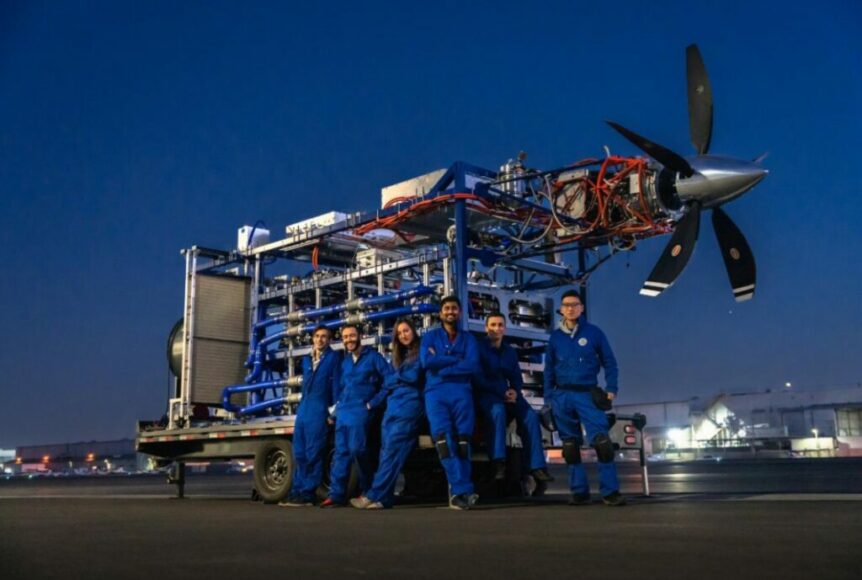In an “end-to-end” demonstration of its proprietary liquid hydrogen module, Universal Hydrogen Co. has successfully run a megawatt-class fuel cell powertrain. “End-to-End,” in this case means “[the] demonstration of a hydrogen molecule moving from our filler/dispenser into our storage module and then into our powertrain is the first time that all the pieces of our product portfolio for regional aviation have come together,” said Paul Eremenko, co-founder and CEO of Universal Hydrogen. “The next step is to upgrade our flight testbed to fly the powertrain fueled by our modules.”
In a simplified interface for a complex process, the liquid hydrogen module “is the core of the company’s fuel services offering for aviation.” Looking like any other intermodal freight and airport cargo handling equipment, each module contains 200 kilograms (440 pounds) of liquid hydrogen. Capable of storing it for long periods without boiloff, the module’s internal systems convert the cryogenic H2 into a warm gaseous H2 consumed by the powertrain
Designed by Universal Hydrogen’s engineering and design center in Toulouse, France, each module includes hydrogen leak detection and venting systems for safe operations, as well as a leak-proof quick-connect for easy installation and removal of the module from the aircraft.
The two-tank container, according to Mark Cousin, Universal’s president and Chief Technical Officer, is “…The largest fuel cell powertrain ever to run on liquid hydrogen, making it another in a series of ‘firsts’ for Universal Hydrogen.” Those tanks ran Universal’s “iron bird” test rig for over one hour and 40 minutes, equivalent to a typical regional flight.
The test, held at Mojave Air and Space Port, marked the first integration of Universal’s module and powertrain. This should help expedite planned service entry for the system in 2026.
The company’s self description shows their intent and direction. “Universal Hydrogen is a hydrogen fuel services provider that uses unique liquid and gaseous hydrogen module technology. The company takes a flexible, scalable, and capital-light approach to hydrogen logistics by transporting it in modular capsules over the existing freight network from green production sites directly to point of consumption, anywhere in the world. The company is targeting regional and narrowbody/single aisle airplanes as the most impactful decarbonization opportunities, while seeking other early applications that can make a difference. Universal Hydrogen is also working to certify a powertrain conversion kit to retrofit existing regional aircraft to fly on hydrogen.”
Universal’s Timeline
The company has a short, busy history. Founded on March 11, 2020 by former Airbus and United Technologies technology chief Paul Eremenko, Universal hired its first employee on May 2, and received its first financial backing on November 17. By December 15, the small team moved to a temporary office in Venice, California and by February 2, 2021, had its first order from Ravn Alaska, a small regional airline.
March 12 saw the first runup of a small scale “iron bird,” a mere shadow of what would come. With Series A financing on April 22, the company was able to expand to facilities in Hawthorne, California (their current headquarters) and Toulouse, France (the firm’s Engineering Center).
Series B financing followed on October 14, and by December 22, Universal signed a European launch customer. Amelia Airlines, described by the International Air Transport Association (IATA) as, “a regional carrier with big environmental ambitions” signed a Letter of Intent (LOI) “for three ATR 72-600 hydrogen conversion kits. This announcement follows Amelia’s November 2021 launch of ‘Amelia Green,’ an internal pledge from the airline to actively find sustainable options to decrease its carbon output.”
On February 15, 2022, Universal ran the first test of its full-scale iron bird, and on March 10 announced plans for its Albuquerque, New Mexico. June 3 saw their signing a deal with Connect Airlines, proposed to fly between Billy Bishop Airport in Toronto and select Midwest and Northeast American cities.
On October 10, American Airlines made a major investment in the company. On October 21, Universal demonstrated its first full-scale module loading. On December 22, the company demonstrated end-to-end module logistics and loading.
The FAA awarded a special airworthiness certificate to the program on February 7, 2023, followed by the first flight of “the world’s largest hydrogen fuel cell airliner” on March 2. The same airplane reached an altitude of 10,000 feet on June 12 and made an 800-mile ferry flight to its current home at the Mojave Air and Space Port, where the full-scale iron bird recently made a successful test. To ice the hydrogen cake, the team is collaborating with JTB Aero Tech to power airport ground support equipment. No more noxious fumes from baggage trains or pushback equipment. More is surely on the way.
Regulatory Cooperation
September 14, 2023 marked “a key regulatory milestone in the race to introduce emissions-free flight and demonstrate to regulators that hydrogen is safe.” Universal received a G-1 certificate, basically a procedural step toward obtaining type certification for aircraft that will be fuel by Universal’s container system.
Since liquid hydrogen is becoming a factor in near-term aviation, such paperwork is a necessary first step. CTO Mark Cousin says, this is “a positive precedent for the rest of the nascent hydrogen aviation industry”.
Overview of the H2 industry
To see where Universal Hydrogen fits into the current H2 movement, check out this overview of what several firms are accomplishing. The future is coming fast.

